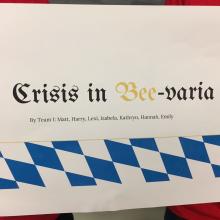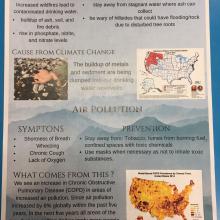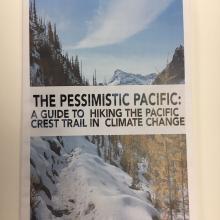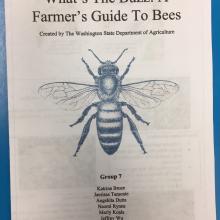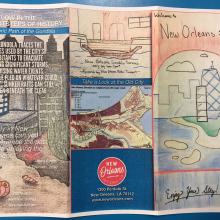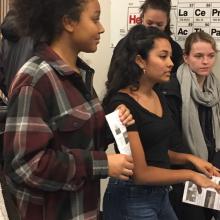Project 4 - Future ::
Field Guides for Living with Climate Change
Climate Change is a controversial topic. While we are used to changing weather patterns, a majority of scientists believe that human actions have altered our global climate. However, it’s a slow process and we often do not yet experience the actual effects of climate change as there exists only predictions on how the conditions on Earth will change. After watching James Balog’s documentary Chasing Ice (2012) and the blockbuster The Day after Tomorrow directed by the German filmmaker Roland Emmerich, students designed their own field guides for living in a future world with climate change.
Team 1: Their field guide “Crisis in Bee-varia” informs about the threat of bee extinction due to changing climate. As the numbers of our traditional bee species are decreasing more and more, their brochure informs about the emergence of new bees such as the “Honey Robo-Bee” or the “German GMO Wasp” that could be found in parks and gardens in Bavaria, Germany, in the future.
Team 2: The team’s handbook “N.Y. Sea: Your manual to Post Climate Disaster America” imagines life in the United States after the big climate catastrophe. Due to rising sea levels, parts of New York will be flooded; however, skyscrapers continue to function as living spaces for the remaining New Yorkers. Their manual informs, among others, about rooftop gardens, and new forms of public transportation for the population who haven’t left the city.
Team 3: The group’s flyer “Diseases in Climate Change” warns about the emergence of new diseases caused by weather-related events such as air pollution and wild fires and gives advice on how people can protect themselves from these illnesses.
Team 4: Their digital field guide “Mushrooms in Washington States” displays the new mushroom species that have emerged in Washington State due to the changing climate. The guide informs mushroom hunters where to find these mushrooms and if they are edible or not.
Team 5: Their handbook “The Pessimistic Pacific: A Guide to Hiking the Pacific Crest Trail in Climate Change” explains how the Pacific Crest Trail will be altered by the effects of climate change. Their guide compares the appearance of the environment today and delivers explanations about the possible differences in the future.
Team 6: The group’s field guide “Welcome to Seattle” informs future inhabitants of Seattle and climate migrants about the living conditions in their new city. Especially the air quality is predicted to change significantly due to the growing number of wild fires in the surrounding areas.
Team 7: Their field guide “What’s the Buzz: A Farmer’s Guide to Bees” educates farmers about the endangerment of bees due to climate change. Their handbook also encourages farmers to help protect the bees by avoiding the use of chemical pesticides that further threatens their existence, particularly in Eastern Washington.
Team 8: The team’s brochure “Welcome to New Orleans” describes how the city of New Orleans is predicted to change because of the effects of climate change. As major parts of the city will be flooded, the city will offer diving tours, and gondola rides to future tourists visiting the city.

